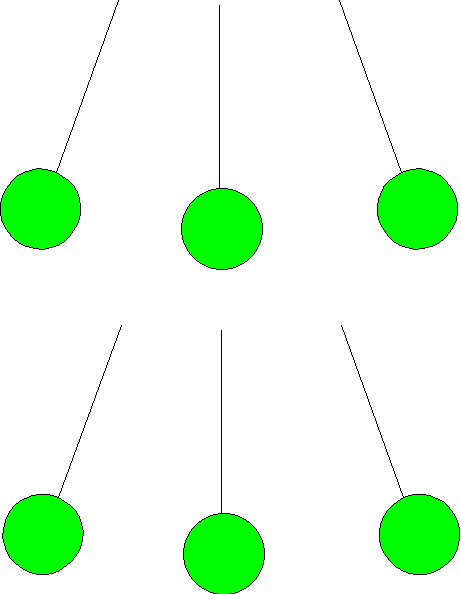
Michael Fowler
Physics 307
Due: 2:00 p.m., Tuesday 14 November.

1.(a) The figure represents a pendulum (a bob-a small round weight, on a string) swinging back and forth, assume it is shown at the furthest point of its swing in each direction and in the middle of the swing. On the first set, show the velocity vector appropriate to these positions in the swing, on the lower set of pictures show the acceleration vectors for the three instants. Don't worry too much about representing the magnitudes, but think carefully about direction.
(Of course, it would be convenient to redraw these on your own sheet of paper.)
(b) Suppose the string is cut as the pendulum swings through the lowest point. Sketch the path of the pendulum from before the swing is cut until well after. How does the velocity of the pendulum the instant before the string is cut compare with that the instant after? How does the acceleration of the pendulum the instant before the string is cut compare with that the instant after?
(c) Now suppose instead the string is cut when the pendulum has reached its furthest point to the right in the swing. Sketch the path of the pendulum from before the string is cut until well after, and again compare the velocity and acceleration of the pendulum the instant before the string is cut with the instant after.
2. A student is sitting at rest on a tall chair (so legs don't reach floor).
(a) Draw a vector representing the force of gravity on the student.
(b) Draw a vector representing the force exerted by the student's weight on the chair.
(c) Draw a vector representing the force of the chair on the student.
(It's ok to show all these vectors on the same diagram, but it must be clear which is which!)
(d) What is the total force on the student? How does this relate to the student's acceleration?
(e) Find all possible pairs of "action and reaction" forces in the sense that the term is used in Newton's Third Law. State carefully each time which bodies these forces are acting on.
3. "When I throw a ball upwards, the force of my hand keeps it going for a while, but then that runs out, gravity takes over, and the ball begins to fall."
State in your own words what is wrong with the above statement.
Write a correct description of this sequence of events: in other words, from the instant your hand begins to move, until the ball is at rest on the ground, state what forces are acting on the ball, and qualitatively, what its acceleration is, during each part of the throw.